Imagine stepping into a kitchen that feels like a warm embrace from nature itself—calming, inviting, and full of character. Earthy Kitchen Ideas have gained immense popularity because they bring a sense of tranquility and authenticity to home cooking spaces, using natural materials, warm tones, and rustic charm.
In this article, you’ll find a delightful mix of ideas that showcase how to transform your kitchen into a cozy, organic haven. Whether you love green accents, reclaimed wood, or stone countertops, there’s something here to inspire your next design adventure. Get ready to discover practical tips and creative touches that will make your kitchen a beautiful reflection of nature’s simplicity and elegance.
1. Warm Wooden Cabinetry with Natural Grain Finishes
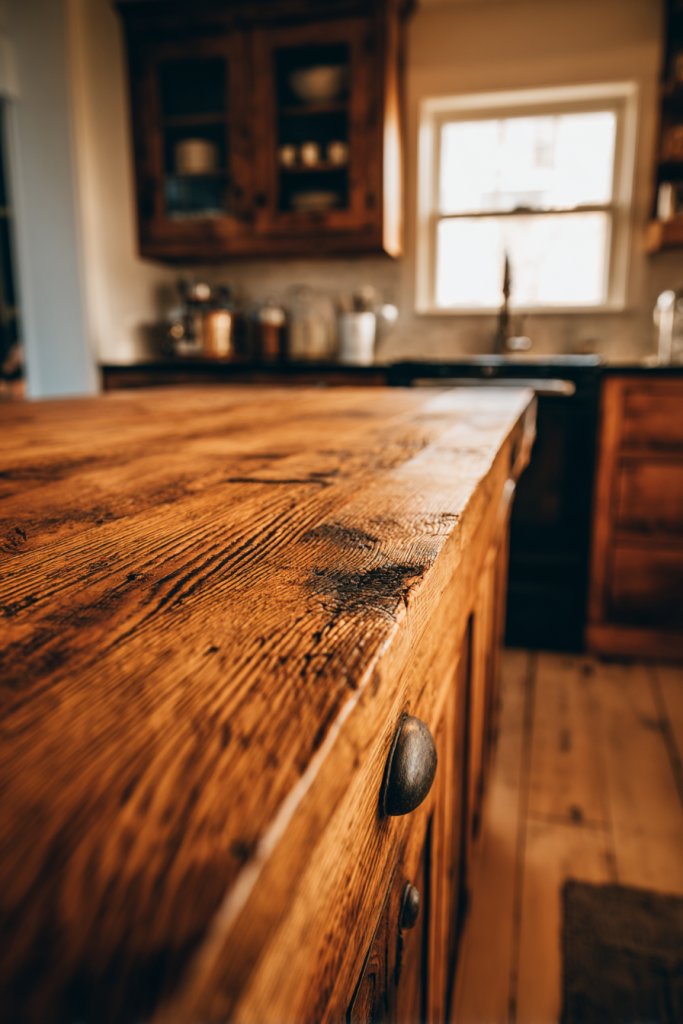
Ever felt overwhelmed by a kitchen that feels cold or sterile? Warm wooden cabinetry brings a cozy, inviting vibe that makes cooking feel like a comforting ritual. It’s about creating a space that feels connected to nature and soothing to the soul. If you crave a kitchen that radiates warmth and authenticity, this idea hits the mark.
Imagine rich, honey-toned cabinets with visible natural grain patterns that catch the light just right. The texture of reclaimed wood adds character, with knots and imperfections telling stories of sustainability and craftsmanship. The warm tones complement earthy-colored walls and natural stone countertops, creating a harmonious, organic feel. This visual warmth invites you to linger in the space, whether cooking or relaxing.
Opt for lighter or darker wood finishes depending on your overall palette. In modern kitchens, sleek panels with subtle grain work beautifully, while rustic spaces benefit from distressed or unfinished textures. Seasonal accents like cozy textiles or woven baskets can elevate the look further. Small kitchens can use vertical grain patterns to add height, while larger spaces enjoy expansive, statement cabinetry.
Start by choosing sustainably sourced or reclaimed wood to stay eco-friendly. Use high-quality veneer or solid wood for durability. Consider natural oils or matte finishes to preserve the organic look while protecting the wood. Measure your space carefully, and work with a skilled carpenter or DIY if you’re handy. Sand and finish the wood to enhance grain visibility, and ensure hardware complements the warm aesthetic. Regular maintenance involves gentle cleaning and re-oiling to keep the wood vibrant.
Personalize by staining or lightly tinting the wood to match your style. Add custom carvings or engraved details for a unique touch. Incorporate open shelving with matching wooden supports for a cohesive look. Finish with soft textiles like linen towels or cotton curtains that echo the warmth of the wood. Mix reclaimed pieces with new to create a curated, layered effect that reflects your personality.
Embracing warm wooden cabinetry connects your kitchen to nature and tradition, boosting both comfort and style. It’s a timeless choice that ages beautifully, gaining character over time. Once you see how natural grain enhances the space, you’ll feel inspired to incorporate organic textures into other areas of your home. Ready to create a kitchen that feels like a warm hug?
2. Stone Countertops with Rustic Textures
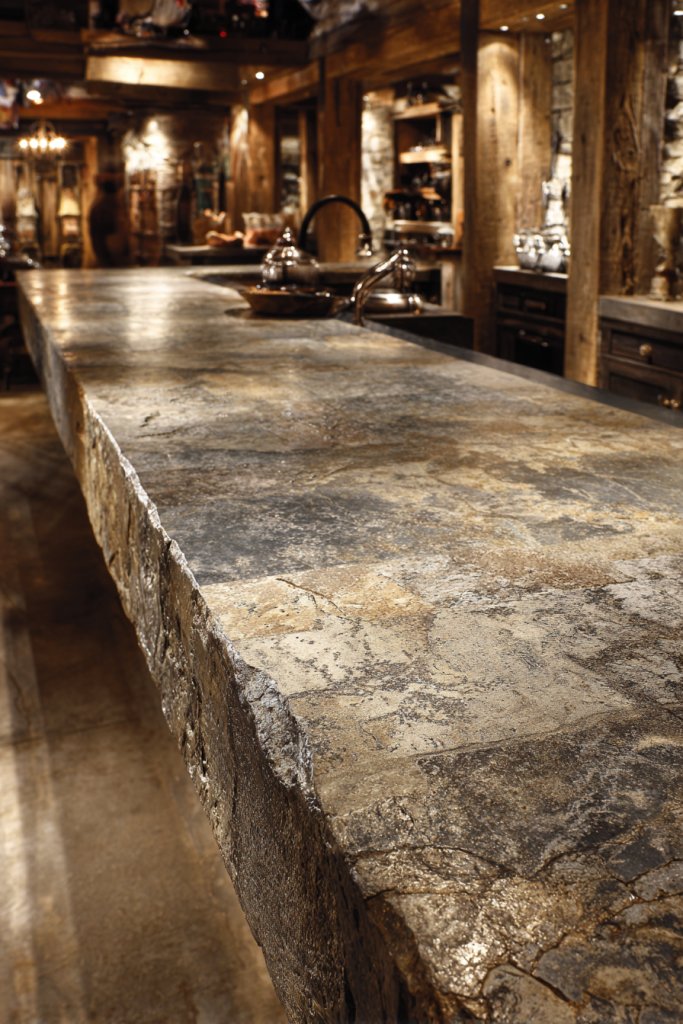
Tired of countertops that look cheap or overly polished? Stone surfaces with rustic textures add a layer of organic authenticity to your kitchen. They’re durable, timeless, and age gracefully, giving your space an earthy charm. If you want your kitchen to feel grounded and natural, this idea is a perfect fit.
Picture a slab of soapstone or slate with a matte, slightly uneven surface that invites touch. The natural variations in color—from deep charcoals to warm browns—highlight the stone’s organic origins. Subtle veins and pits add character, making each countertop unique. This tactile surface pairs beautifully with raw wood or terracotta accents, creating a rustic yet refined vibe.
Choose lighter stones like travertine for softer, brighter spaces or darker stones for a dramatic look. Incorporate textured or honed finishes for less shine and more tactile appeal. Seasonal accessories like woven placemats or clay pottery can enhance the rustic feel. For a contemporary twist, combine rustic stone with sleek, minimalist cabinetry for contrast.
Select high-quality natural stone from reputable suppliers, checking for proper sealing and treatment. Consider honing or brushed finishes to emphasize textures and reduce glare. Professional installation ensures proper sealing to prevent staining and damage. Regular maintenance includes gentle cleaning with pH-neutral cleaners and resealing annually. For DIY enthusiasts, many stones can be cut and sealed with the right tools, but a pro helps ensure longevity.
Personalize with custom edge profiles—bevel, chiseled, or rough-cut—to match your style. Pair with open shelving or vintage cabinets to boost rustic appeal. Use natural fiber rugs and handcrafted pottery to complement the textures. Incorporate contrasting materials like copper or wrought iron fixtures for added warmth and character. Each detail reinforces the organic, earthy ambiance.
Rustic stone countertops are about embracing nature’s imperfections and celebrating durability. They age gracefully, developing a lovely patina that tells your kitchen story. This choice aligns with sustainability and craftsmanship, making your space both functional and soulful. Ready to elevate your kitchen with natural textures?
3. Open Shelving with Raw Wooden Boards
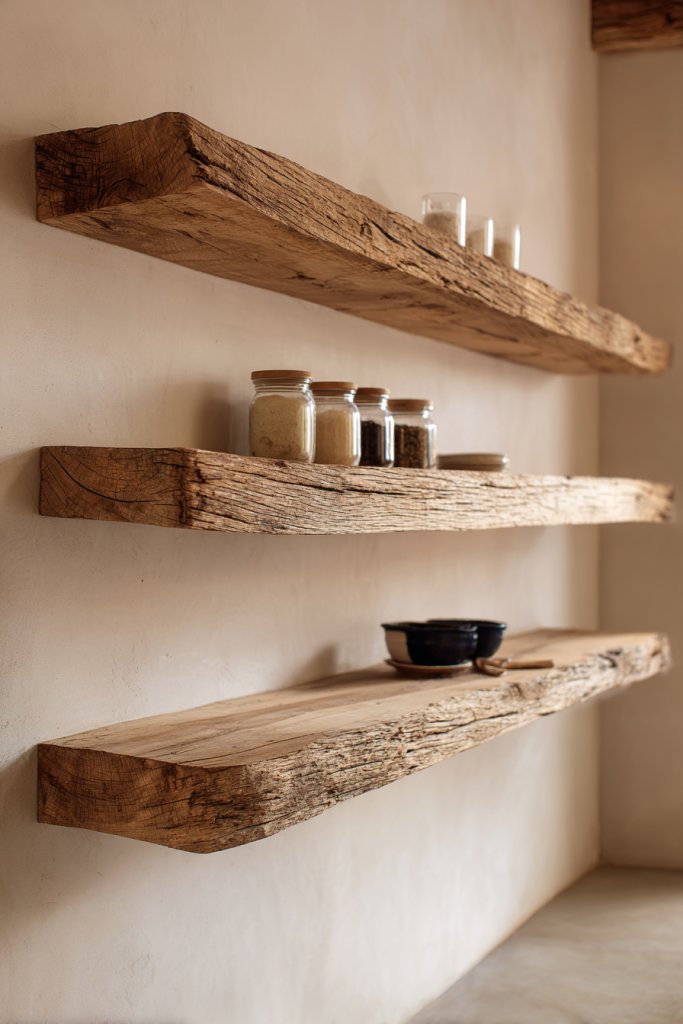
Cluttering your counters with endless jars and utensils? Open shelving made from raw wooden boards offers a stylish, clutter-friendly alternative. It creates a casual, accessible vibe that feels both functional and relaxed. If you crave a kitchen that’s easy to organize and visually warm, this idea is your answer.
Imagine shelves crafted from unfinished or lightly stained wood, with visible grain and knots. They hold everyday essentials—pots, bowls, and simple glass jars—without feeling overwhelming. The natural imperfections and raw edges add character and authenticity. Light bounces off the textured wood, warming the space and making it feel inviting.
Use thick, reclaimed wood for a rustic look or sleek, sanded planks for a contemporary touch. Mix open shelving with closed cabinets for balance. Seasonal swaps like colorful textiles or vintage kitchen tools can refresh the look. Floating shelves in different lengths add visual interest and allow flexible storage options.
Start by selecting sturdy, untreated wood—preferably reclaimed or sustainably sourced. Attach with hidden brackets or robust dowels, ensuring stability. Sand edges lightly to maintain a natural feel but avoid over-polishing. Mount at a height that allows easy access and prevents clutter. Seal the wood with food-safe oil or wax if you plan to store edible items directly on the shelves.
Personalize with painted or stained supports, or add small decorative brackets for a vintage look. Incorporate hooks underneath for hanging utensils or mugs. Use baskets or fabric-lined trays to organize smaller items. Display handcrafted ceramics or vintage finds to add a personal touch that enhances the organic aesthetic.
Open shelving makes your kitchen feel more approachable and lived-in. It encourages you to curate what you display, turning everyday essentials into decor. Plus, it’s an easy upgrade that adds warmth and character without breaking the bank. Your kitchen will feel more authentic and welcoming in no time.
4. Earth-Toned Backsplash Tiles in Natural Materials
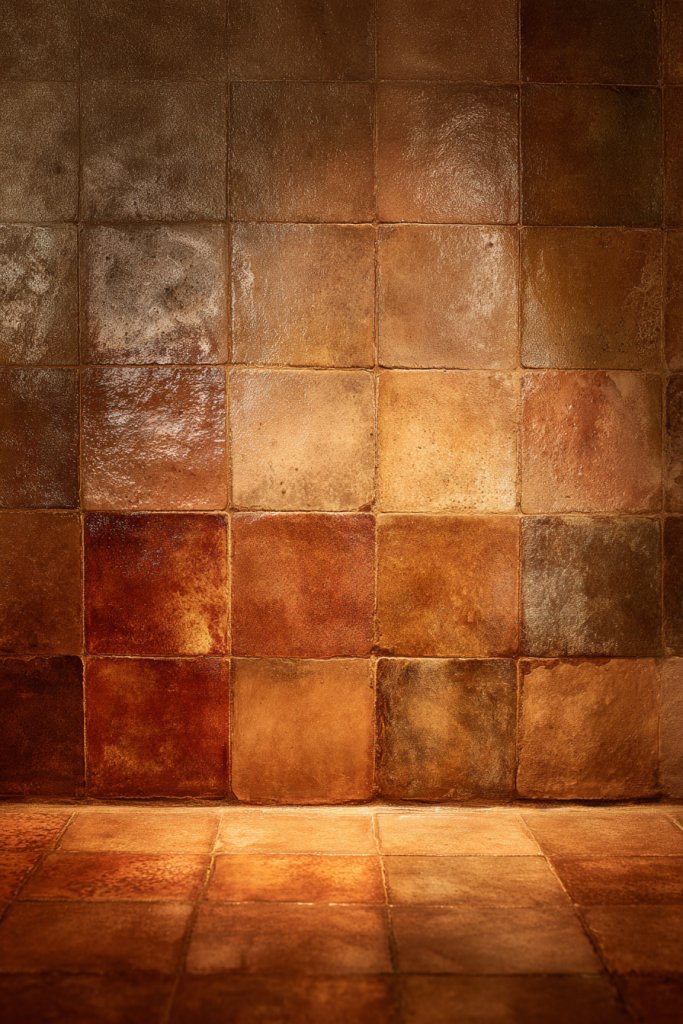
Looking to add warmth and texture without clutter? Earth-toned backsplash tiles in natural materials instantly elevate your kitchen’s organic vibe. They create a seamless transition between counters and walls, adding depth and visual interest. If you want a subtle yet impactful feature, this idea is a winner.
Picture terracotta or pebble mosaics laid in warm browns, beiges, and rust hues. The textured surfaces evoke a natural landscape or sandy beach, inviting tactile exploration. The irregular edges of handcrafted tiles add an artisanal charm, making each installation unique. Soft lighting enhances these textures, creating a cozy, earthy glow.
Choose matte, unglazed tiles for a raw, organic feel or glazed tiles for a slight sheen. Incorporate textured or irregular shapes for a handcrafted look. For a more modern twist, pair earthy tiles with sleek, minimal cabinetry. Seasonal decor can include woven accents or clay pottery to complement the natural palette.
Select durable, high-quality tiles suited for kitchen environments. Opt for natural clay, stone, or ceramic materials that resist stains and heat. Use flexible mortar and high-quality grout to ensure longevity. Professional installation guarantees precise placement, especially with irregular shapes. Seal the finished backsplash to protect against splashes and stains, and clean tiles with gentle, non-abrasive cleaners.
Add decorative borders or accents in contrasting textures. Incorporate custom patterns or motifs inspired by nature—leaf, wave, or mountain shapes. Pair with natural fiber textiles or handcrafted wooden accessories for a layered, organic look. Regularly clean and reseal to maintain the earthy textures and colors.
Natural material backsplashes connect your space to the earth’s beauty and craftsmanship. They age gracefully and develop a patina that adds character. Embracing these materials makes your kitchen feel rooted in tradition yet timelessly stylish. Ready to bring the outdoors inside?
5. Matte Finish, Neutral-Colored Appliances
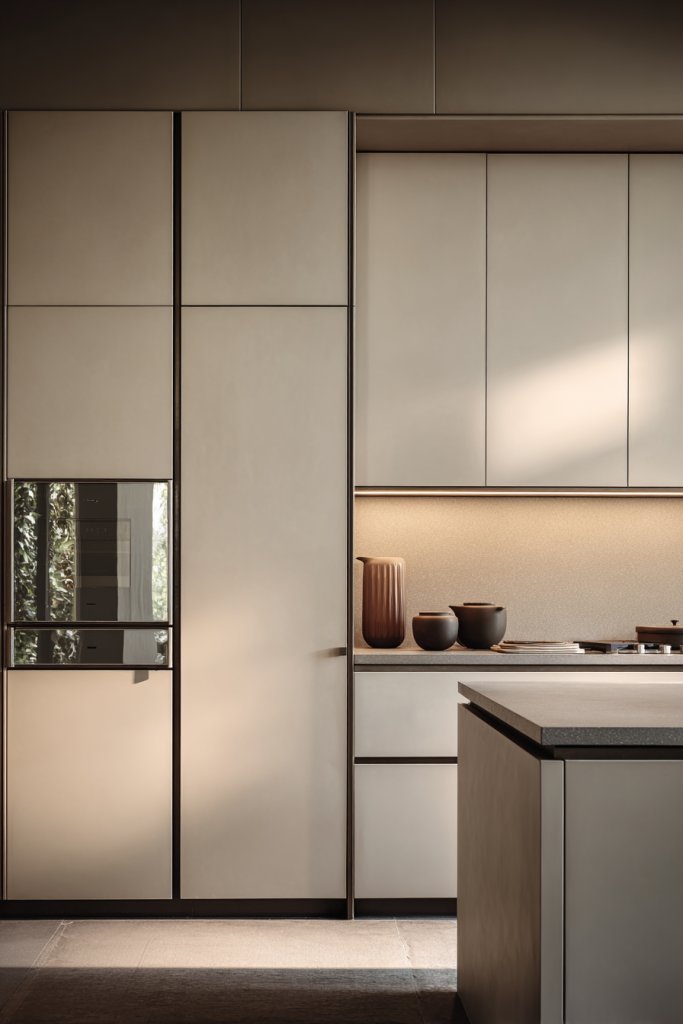
Brighter, shiny appliances can sometimes clash with an earthy, organic decor. Matte-finished, neutral-colored appliances blend seamlessly into a natural palette, creating a calm and cohesive kitchen. If you want modern functionality without sacrificing warmth, this idea is your solution.
Visualize appliances in muted shades like olive green, matte black, or warm beige, with soft, non-reflective surfaces. Their understated hues complement natural wood and stone, avoiding visual noise. The matte finish reduces fingerprints and smudges, maintaining a clean, organic look over time. These appliances quietly support the aesthetic rather than dominate it.
Choose appliances with rounded edges and simple controls for a softer appearance. Pair with vintage-inspired hardware or textured handles to add tactile interest. Seasonal styling can involve colorful textiles or handcrafted pot holders to bring subtle pops of color. For small spaces, compact models in muted tones maximize visual harmony.
Research brands offering matte finishes in earthy tones—many now prioritize eco-friendly manufacturing. Prioritize appliances with energy-efficient ratings for sustainability. Installation is straightforward but ensure proper space planning for ventilation. Regular cleaning involves gentle, non-abrasive cloths—avoid harsh chemicals to preserve the matte surface. Opt for models with customizable panels for a seamless look.
Add personalized touches like engraved or textured panels. Incorporate tactile accessories such as raw linen towels or handcrafted wooden utensils nearby. Use matching or contrasting textured countertops to create visual interest. Seasonal updates could include soft fabric covers or painted hardware accents.
Neutral matte appliances elevate your space with understated elegance and practicality. They allow natural textures and colors to shine, creating a peaceful environment. Once you see how they blend effortlessly, you’ll feel confident designing the rest of your kitchen around them. Simple, stylish, and sustainable—what’s not to love?
6. Clay or Ceramic Pottery as Functional Decor
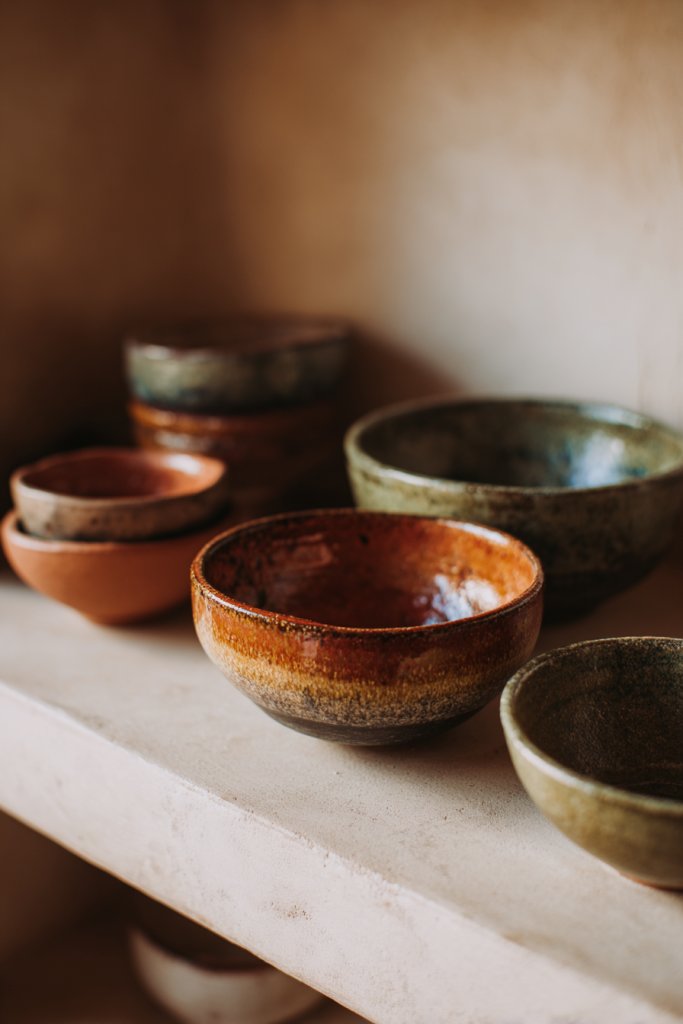
Tired of plain, generic kitchen accessories? Handcrafted clay or ceramic pottery adds a personal, artisanal touch to your space. These pieces serve both functional and decorative purposes, blending utility with organic beauty. If you want your kitchen to feel cozy and authentic, this idea delivers.
Imagine bowls with uneven rims, textured surfaces, and warm earthy glazes. Utensil holders and serving dishes in natural clay evoke craftsmanship and warmth. Their imperfect, handcrafted look contrasts beautifully with sleek modern fixtures, creating a balanced aesthetic. The tactile quality invites touch and enhances the sensory experience.
Choose pieces with matte or semi-gloss finishes in natural hues like terracotta, ochre, or muted greens. Mix different shapes and sizes for an eclectic yet cohesive look. Incorporate decorative elements like carved patterns or painted details for a personalized touch. Use them to hold utensils, spices, or display fresh produce—if storage permits.
Source from local artisans or craft markets to support sustainable practices. Choose durable, food-safe glazes and avoid overly glossy finishes that look commercial. Place on open shelves or countertop corners for easy access. Maintain by hand-washing with gentle soap and avoiding harsh abrasives. To preserve the earthy look, avoid over-polishing; let the natural textures shine.
Add personal touches with painted or carved initials, symbols, or patterns. Pair with woven textiles or wooden accents to enhance the organic feel. Display as a centerpiece or mix with vintage metal pieces for contrast. Regularly update with seasonal or themed pottery to keep the look fresh and personal.
Using handcrafted pottery connects your kitchen to tradition and artistry. These pieces age beautifully, gaining character over time. They turn everyday routines into moments of aesthetic pleasure. Embrace the imperfection and craft your own organic, welcoming space.
7. Woven Baskets for Storage and Organization
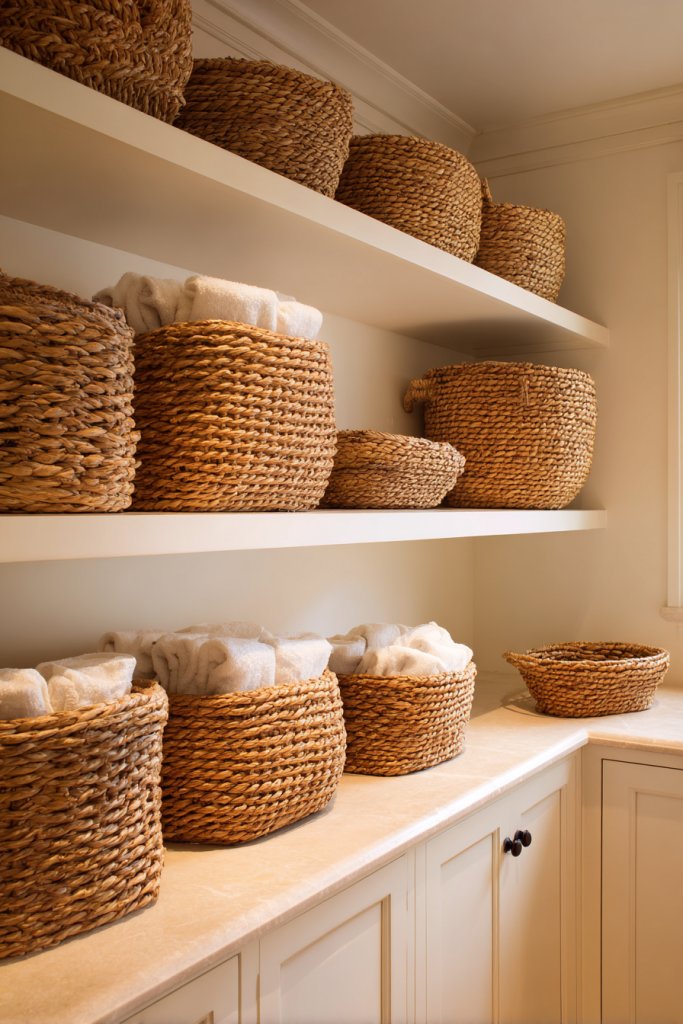
Cluttered counters and cabinets make for a stressful kitchen. Woven baskets offer a stylish, natural solution to keep things organized while adding texture. They’re perfect for storing produce, linens, or utensils without disrupting your earthy aesthetic. If tidiness and style matter equally, this idea is gold.
Picture jute, seagrass, or rattan baskets filled with fresh fruit or neatly folded towels. Their warm, tactile surfaces contrast beautifully with smooth ceramic or stone surfaces. Visible weaving patterns and natural fibers add depth and interest. Baskets in various sizes can be stacked or nested, creating a layered, cozy look. Their imperfect shapes and textures enhance the organic vibe.
Select baskets with open weaves for ventilation or tightly woven for a cleaner look. Use fabric liners for added protection and color. Incorporate hooks or handles for easy access or stacking. Seasonal swaps include replacing linen-lined baskets with woven trays for serving or display. Mix traditional shapes with modern geometric styles for a contemporary touch.
Choose natural, sustainable fibers that resist wear and moisture. Properly clean and treat baskets to prevent mold or pests. Use them on open shelves, countertop corners, or inside cabinets. Combine with other organic materials like wood or clay for a layered look. Regularly dust and occasionally re-treat with natural oils to preserve fibers.
Personalize with painted or dyed patterns, or add leather straps for a rustic touch. Use for seasonal decor—filled with pinecones or dried flowers. Incorporate labels or tags made from natural materials for easy identification. Pair with textured textiles like linen or burlap for a warm, cohesive style.
Woven baskets are versatile, eco-friendly, and timeless. They simplify organization while adding warmth and texture. Over time, they develop a beautiful patina that enhances their organic charm. Your kitchen will feel more inviting and thoughtfully curated.
8. Neutral Linen or Cotton Textiles for Curtains and Towels
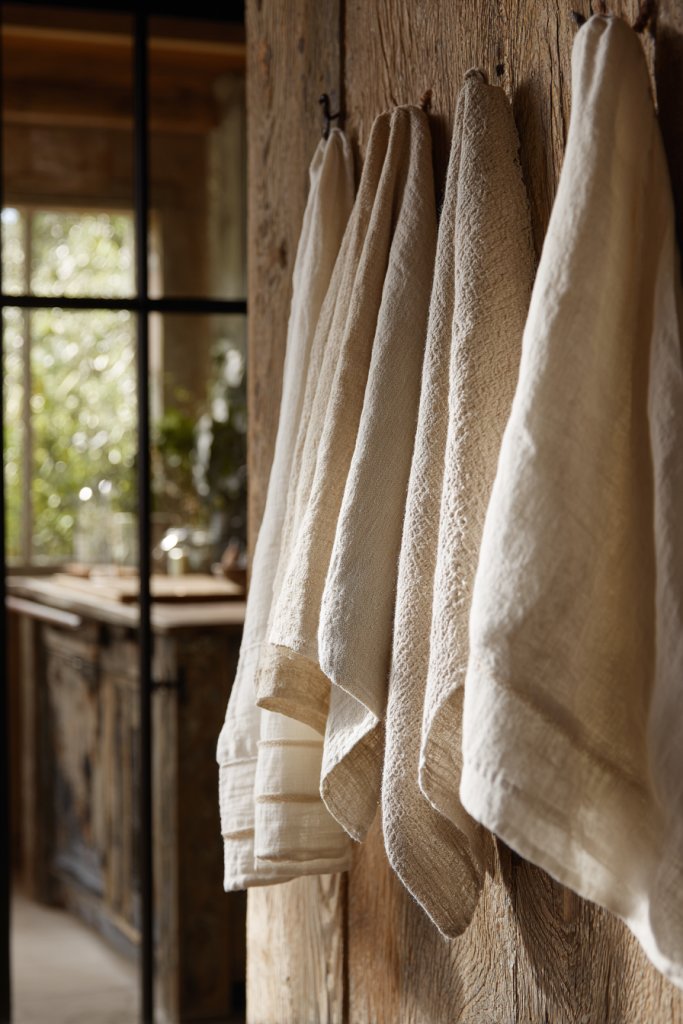
Bright, synthetic fabrics can clash with a natural, earthy kitchen vibe. Organic linen or cotton textiles soften the overall look while adding functionality. They provide a tactile, cozy layer that makes your space feel warm and inviting. If you’re after a subtle touch of comfort, this idea is perfect.
Imagine flowing, beige or ochre curtains framing your windows, catching light and adding a gentle glow. Kitchen towels made from textured linen or cotton drape casually over handles or hooks, introducing tactile interest. Their natural fibers showcase subtle variations and a matte finish that pairs effortlessly with wood and stone. The softness of the fabric contrasts beautifully with rugged surfaces.
Opt for simple, unbleached or lightly dyed fabrics for an authentic look. Layer different textures—like a waffle weave or gauze—for added depth. Change seasonal textiles to reflect your mood or decor shifts, such as adding a dash of color with terracotta or olive green. For smaller spaces, use Roman shades or tie-up curtains to maximize light.
Choose high-quality, organic fabrics that are breathable and sustainable. Sew or buy ready-made curtains and towels in neutral tones. Hang with wooden or metal rods that complement your earthy palette. Wash with gentle, eco-friendly detergents to maintain softness and color. For durability, line curtains with a natural lining or leave them unlined for a breezy feel. Keep towels visible and accessible for daily use.
Add embroidered or stitched accents for a personal touch. Mix and match different weave patterns for visual interest. Use decorative clips or rings made from natural materials. Incorporate seasonal accents like a soft cream throw blanket with chunky knit texture or printed textiles dyed with natural pigments. These small details personalize your space effortlessly.
Organic textiles create a calm, inviting atmosphere rooted in nature. They’re simple to update and maintain, making your kitchen feel fresh and cozy. Once you embrace natural fabrics, you’ll see how they elevate the overall aesthetic while providing everyday comfort. It’s a small touch with a big impact.
9. Exposed Beams and Structural Elements in Natural Wood
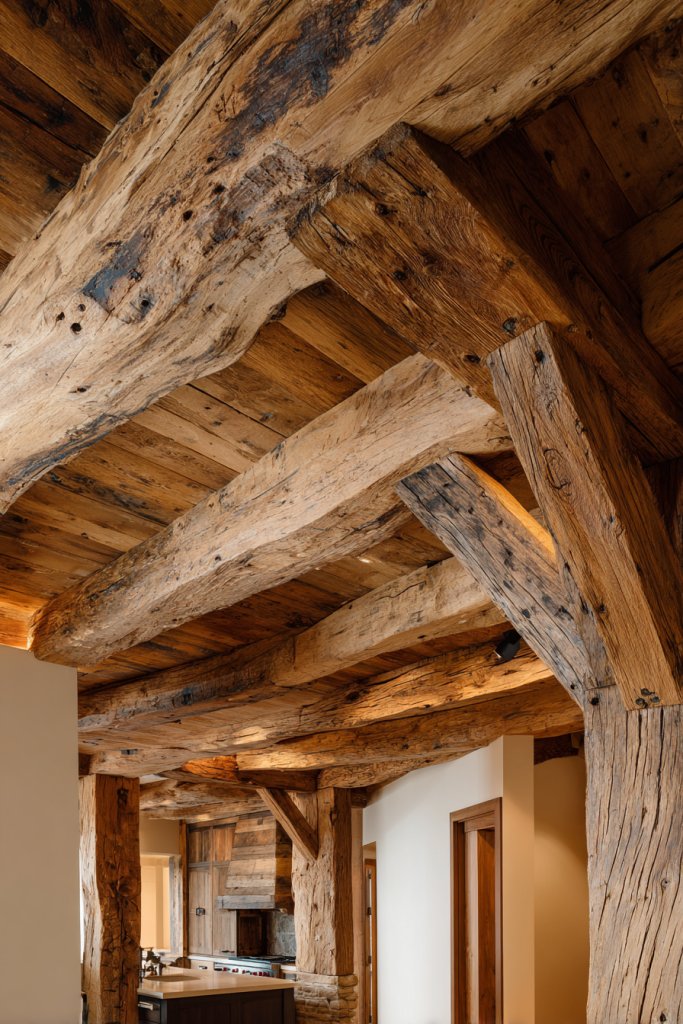
Sometimes the architecture of your kitchen feels flat or uninspired. Exposed beams and structural elements in natural wood add architectural interest and a raw, organic feel. They celebrate craftsmanship and bring a sense of history and honesty to your space. If you want a kitchen with real character, this idea is a game-changer.
Picture rustic wooden beams crossing the ceiling, their rough-hewn surfaces showcasing natural grain and imperfections. These beams anchor the space, creating a visual dialogue between old-world craftsmanship and modern design. The warm tones of the wood contrast with neutral walls, adding depth and dimension. When paired with open shelving or stone accents, they evoke a cozy, barn-like charm.
Opt for reclaimed or distressed wood to enhance authenticity. For a minimalist look, keep beams simple and unadorned, or add decorative carvings for extra detail. If structural beams aren’t feasible, faux beams made from lightweight materials can mimic the look. Seasonal touches like woven or fabric accents work well beneath exposed wood for a layered feel.
Consult a structural engineer or carpenter to ensure safety and stability before installation. Reclaimed wood adds sustainability and authenticity, but ensure it’s properly treated to prevent pests. Finish with natural oils or stains that enhance grain while protecting the wood. Proper sealing on joints and edges ensures longevity. Regular inspections and gentle cleaning maintain the rustic charm.
Decorate beams with subtle lighting, such as LED strips or sconces, to highlight their texture. Add vintage or handcrafted fixtures beneath for cohesion. Integrate other natural elements, like stone or clay, to complement the wood. Keep the overall look simple and organic—avoid overly polished finishes or excessive ornamentation.
Exposed beams connect your kitchen to traditional craftsmanship and natural beauty, adding warmth and authenticity. They improve the overall architectural interest and can increase property value. Once installed, they become the defining feature that reflects your appreciation for organic, honest design. It’s a bold yet timeless choice.
10. Eco-Friendly Lighting with Warm, Soft Glows

Harsh, cool lighting can kill the cozy, earthy vibe you’re aiming for. Eco-friendly lighting options that emit warm, soft glows transform your kitchen into a welcoming sanctuary. They’re better for the environment and your mood, creating a space you’ll want to linger in. If you crave ambiance and sustainability, this idea is a win.
Imagine pendant fixtures made from clay or wood, casting a gentle, amber-hued light over your workspace. Sconces with warm-toned bulbs highlight textured walls and natural materials. The glow softens shadows and enhances the tactile qualities of stone and wood. The overall effect is calming and inviting, like a cozy cabin or rustic retreat.
Choose fixtures with dimming options to adjust mood based on the time of day or occasion. Incorporate fixtures with natural materials—bamboo, cork, or reclaimed wood—for a truly organic feel. Seasonal lighting swaps, such as string lights or lanterns, can add a whimsical touch. The key is balancing function with warm, diffuse illumination that complements the earthy palette.
Select energy-efficient LED bulbs with warm color temperatures (around 2700K). Use fixtures made from natural, sustainable materials, ensuring they fit your design style. Install with proper wiring and consider layered lighting—ambient, task, and accent—to create depth. Regularly clean fixtures and check connections for safety and performance. Use smart controls or timers to enhance energy savings.
Add handcrafted or vintage-inspired fixtures for authenticity. Incorporate candles or lanterns for special occasions or cozy evenings. Use natural fiber or linen lamp shades to soften the light further. Personal touches like etched glass or carved wood can personalize your lighting setup, making it uniquely yours.
Thoughtfully chosen warm lighting elevates your kitchen’s organic feel and supports sustainable living. It creates a peaceful environment that’s both functional and aesthetically pleasing. Once you experience the difference, you’ll want to upgrade all your fixtures to match this warm, inviting style. Better lighting, better mood, better life.
11. Greenery in Minimalist, Organic Planters

Want to add a touch of life without overwhelming your earthy aesthetic? Small, minimalist planters with low-maintenance herbs or succulents bring subtle greenery into your kitchen. They add freshness and color while keeping things simple and modern. If you’re hesitant about lush plants, this understated approach is perfect.
Visualize simple ceramic or terracotta pots in neutral tones—beige, taupe, or muted green—placed on open shelves or countertops. They hold tiny herbs like basil or thyme, or drought-tolerant succulents with sculptural shapes. The minimal design emphasizes natural textures and colors, blending seamlessly with wood and stone surfaces. These small pops of green inject vitality without clutter.
Choose sleek, geometric planters for a modern look or rustic clay pots for a more organic feel. Display a few on a windowsill or clustered on a tray for visual cohesion. Seasonal changes can include swapping in dried herbs or decorative stones. Incorporate matching or contrasting textures to keep the aesthetic unified.
Source from local nurseries or online shops that prioritize eco-friendly materials. Use well-draining soil and appropriate pots with drainage holes. Place in well-lit areas, but avoid direct harsh sunlight for delicate plants. Regular watering with filtered or rainwater keeps them healthy. Wipe down pots occasionally to maintain their clean, minimalist appeal.
Label your herbs with simple wooden tags or engraved stones. Mix different textures and shapes within your plant groupings. Incorporate decorative stones or sand for contrast. Change your plant selections seasonally or for special occasions to keep your kitchen lively and personal.
Adding small greenery elements brings life and balance to your earthy kitchen decor. They’re easy to care for and can be a rewarding way to connect with nature daily. Once you see how subtle greenery enhances your space, you’ll be motivated to expand your plant collection organically.
12. Textured Wall Finishes in Natural Hues

Flat, painted walls can feel uninspired or clinical. Textured finishes in natural hues add depth and tactile interest, transforming your walls into organic artworks. They make a subtle statement that enhances the overall earthy vibe. If you want walls that invite touch and admiration, this idea is essential.
Imagine walls coated with lime plaster or clay paint, creating a soft, uneven surface that catches light and shadow. The subtle variations in color—from warm taupe to sandy beige—enhance the natural aesthetic. Textured wallpaper with organic patterns, such as ripples or leaf motifs, adds further depth and visual intrigue. The result is a space that feels layered and alive.
Choose finishes that match your preferred level of texture—from lightly troweled to heavily textured. Use natural, non-toxic materials that breathe and age gracefully. Seasonal accents like woven or fabric wall hangings can complement the textures. Keep the color palette neutral to emphasize the tactile qualities and create a calming environment.
Work with skilled artisans or DIY with proper tools—such as trowels, sponges, or brushes—to achieve your desired texture. Use natural clay or lime-based paints for authenticity and eco-friendliness. Prepare your walls by cleaning and priming before applying textures. Seal with breathable, natural finishes to preserve the look and prevent damage. Regular gentle cleaning maintains the tactile appeal.
Incorporate subtle color shifts or metallic accents for added richness. Use textured finishes behind open shelving or in focal areas to draw attention. Pair with organic textiles or handcrafted frames for a cohesive look. Seasonal updates can involve changing wall hangings or adding natural fiber tapestries.
Textured walls in natural hues create a warm, inviting atmosphere rooted in craftsmanship. They add depth and character without overwhelming the senses. Embracing tactile finishes makes your space truly unique and timeless. It’s a simple way to bring natural artistry into your daily life.
13. Reclaimed Wood Dining Table or Counter Stools

Dining furniture often feels mass-produced and uninspired. Reclaimed wood tables and stools bring sustainability and character into your kitchen. They add warmth and history, making every mealtime special. If you crave authentic craftsmanship, this idea will resonate deeply.
Picture a rustic, weathered table with visible knots and grain, paired with matching stools in a distressed finish. The natural imperfections tell stories of previous lives and add charm. The warm, uneven tones complement earthy walls and stone countertops, creating a cozy, inviting vibe. These pieces evoke a sense of craftsmanship and sustainability.
Choose from different finishes—from rough-hewn to smoothly sanded—depending on your style. Incorporate accessories like linen runners or handcrafted ceramics to enhance the organic look. Mix vintage with modern elements for an eclectic aesthetic. For smaller spaces, opt for a reclaimed bench or a fold-away table to maximize versatility.
Source reclaimed wood from sustainable suppliers or salvage yards. Ensure the wood is properly dried and treated for safety and durability. Consider DIY projects or hire artisans for custom pieces. Seal the wood with natural oils or beeswax to protect and enhance grain. Maintain by cleaning gently and re-oiling periodically.
Personalize with carved initials, painted motifs, or unique hardware. Use textiles like tablecloths or placemats made from organic fabrics. Incorporate soft lighting like candles or lanterns (not electrical fixtures) to accentuate the rustic charm. Mix in recycled or vintage accessories for added authenticity.
Reclaimed wood furniture connects your space to sustainability and craftsmanship. It ages beautifully, gaining character over time. These pieces create a warm, inviting atmosphere that feels both timeless and eco-conscious. Your kitchen will radiate organic charm and personalized style.
14. Handcrafted Wooden Utensils and Cutting Boards
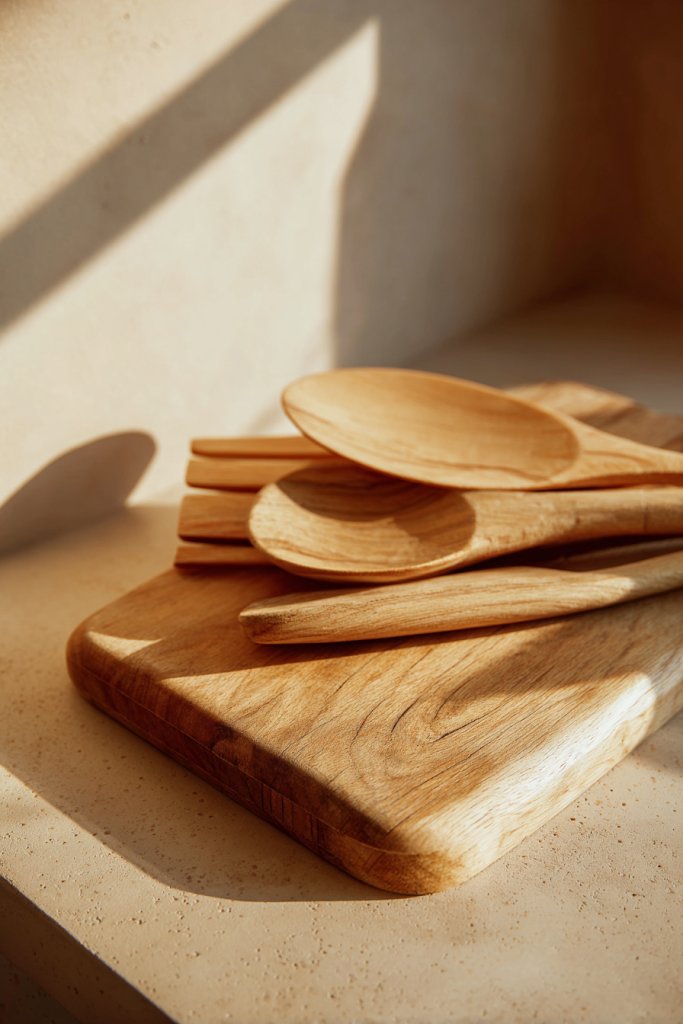
Standard plastic utensils lack charm and sustainability. Handcrafted wooden utensils and cutting boards add warmth, character, and a touch of artistry to your kitchen essentials. They elevate everyday routines into moments of connection with nature. If you want functional decor, this idea is ideal.
Visualize smooth, rounded spoons, spatulas, and chopping boards in warm woods like cherry, maple, or walnut. The natural grain patterns and hand-carved details showcase craftsmanship. These pieces look beautiful on open shelves or countertop displays, turning utilitarian objects into art. Their tactile quality invites you to touch and use them daily.
Choose minimalist, sleek designs or rustic, carved motifs depending on your style. Mix different wood tones for visual interest. Add engraved initials or symbols for personalization. Use matching sets for a cohesive look or eclectic pieces for charm. Incorporate natural fiber or linen storage bags for a complete organic aesthetic.
Source from local artisans or craft markets for authentic pieces. Opt for food-safe finishes like beeswax or mineral oil to preserve the wood. Hand wash and dry immediately to prevent cracking. Regularly re-oil the utensils and boards to maintain their appearance and durability. Store in accessible, natural-fiber-lined containers.
Add personal touches with carved initials, painted patterns, or custom shapes. Pair with linen or cotton towels in neutral shades for a layered look. Display prominently on open shelving or hang from hooks for easy access. Seasonal variations might include painted or stained accents.
Using handcrafted wooden utensils connects you with traditional craftsmanship and sustainable materials. They develop a beautiful patina with age, adding character over time. These tools make your kitchen more functional and aesthetically rich. Ready to craft or collect your organic, artisanal essentials?
15. Natural Fiber Rugs and Mats in Neutral Shades

Cold, synthetic rugs can feel out of place in an earthy kitchen. Natural fiber rugs and mats—made from jute, coir, or sisal—bring warmth, texture, and sustainability underfoot. They tie the space together while adding a layer of tactile comfort. If you’re after a grounded, authentic look, this is your move.
Imagine a coir mat with a woven, textured surface in muted beige or tan, placed near the sink or doorway. The natural fibers have a rough, tactile appeal that contrasts beautifully with smooth stone or wood floors. Layered rugs or mats create depth, and their imperfect edges reinforce the organic aesthetic. They absorb sound and add visual warmth.
Choose flat-woven or braided styles for a sleek, modern look or thick, shaggy textures for cozy comfort. Use layered rugs for visual interest or overlap different shades for subtle variation. Seasonal updates could include adding colorful woven textiles or natural fiber runners. Pair with simple, organic textiles for a cohesive style.
Select high-quality, densely woven fibers resistant to wear and moisture. Regularly vacuum and shake out to keep clean. For added longevity, treat with natural oils or sealants suitable for fibers. Place in high-traffic areas but avoid excessive moisture to prevent mold. Rotate and flip the rugs periodically for even wear. Consider custom sizes for perfect fit.
Incorporate decorative borders or subtle dyed accents. Use natural fiber mats as bases for potted herbs or small display items (avoiding restricted decor, of course). Add a touch of color with layered textiles or small woven baskets nearby. Seasonal changes can include adding fringes or switching to more colorful fibers.
Natural fiber rugs make your kitchen feel warm and organic, grounding the space. They’re eco-friendly and develop a lovely patina over time, adding character. Once you embrace their texture and durability, you’ll see how they enhance the overall earthy ambiance. Step onto comfort and sustainability.
16. Minimalist, Organic-Inspired Hardware and Fixtures

Overly ornate or shiny fixtures can distract from a natural, earthy aesthetic. Minimalist hardware in bronze, copper, or black matte finishes offers subtlety and sophistication. They provide functional details while enhancing your space’s organic vibe. If you appreciate understated elegance, this is your upgrade.
Visualize sleek, brushed metal handles and knobs with simple, clean lines—avoiding unnecessary embellishments. The warm tones of bronze or copper develop a natural patina over time, adding character. Fixtures mounted on rough-textured wooden cabinets or matte stone countertops look effortless and harmonious. Their subtle sheen complements organic textures without overpowering them.
Select hardware with rounded or slightly textured surfaces for tactile appeal. Pair with natural wood or stone accents for a cohesive look. Seasonal updates can involve switching out handles for different finishes or adding decorative pulls made from natural materials like leather or clay. Keep designs simple for a truly organic feel.
Choose high-quality, corrosion-resistant fixtures designed for kitchen use. Measure carefully to ensure proper fit and placement. Install with basic tools, or hire a professional for a seamless look. Regularly clean with gentle, non-abrasive cloths, and polish metal fixtures with natural oils to maintain their finish. Avoid over-tightening to prevent damage.
Personalize with engraved or textured details—such as leaf motifs or organic shapes. Combine hardware with textured cabinet finishes or hand-finished wood for a layered organic aesthetic. Use complementary fixtures like aged hooks or vintage-inspired knobs. Seasonal updates can involve swapping handles or adding decorative accents.
Organic-inspired hardware ties your entire kitchen together with subtlety and style. They age beautifully and develop a unique patina, adding depth to your design. Once you see how they elevate your space, you’ll be motivated to keep the organic theme consistent. Elegant, simple, and sustainable—your kitchen’s finishing touch.
17. Artistic Touches with Natural Dyes or Textured Art

Flat, mass-produced art can feel out of place in a natural, earthy kitchen. Hand-dyed textiles or textured art pieces in natural pigments bring a personal, organic touch. They add depth and character without overwhelming the space. If you want your decor to tell a story, this idea is perfect.
Imagine wall hangings or fabric art created with plant-based dyes—think deep greens, warm ochres, or earthy browns. Textured art, such as woven wall hangings or clay reliefs, invites touch and visual interest. Natural materials like jute, hemp, or linen form the backdrop, emphasizing sustainability. These pieces evoke craftsmanship and authenticity.
Use large, simple textiles with organic patterns for a statement wall, or smaller framed works for subtle accents. Incorporate textured or layered fabric pieces for tactile richness. Seasonal updates can involve switching out textiles for different colors or motifs inspired by nature. Pair with handcrafted frames or wooden mounts for cohesion.
Create or commission textiles dyed with natural pigments—indigo, madder, or turmeric—using eco-friendly methods. For textured art, explore weaving, clay reliefs, or embroidery. Mount on reclaimed wood or natural fiber canvases. Hang using simple hardware, avoiding over-decoration to keep focus on the organic material. Regular gentle cleaning preserves their integrity.
Add embroidered or painted details that reflect personal symbols or nature motifs. Incorporate natural fiber mats or woven baskets nearby for a layered look. Seasonal or thematic updates can change with the year’s cycles—dried flowers, leaves, or botanical prints. Keep the color palette neutral to sustain the earthy, organic aesthetic.
Textured and natural-dyed art pieces deepen the organic feel of your kitchen and showcase your creative side. They age beautifully and become more meaningful over time. These touches turn your space into a personal gallery rooted in nature’s palette and craftsmanship. Embrace your inner artist and craft a truly organic decor.
18. Simple, Unfinished Edges on Shelving and Countertops
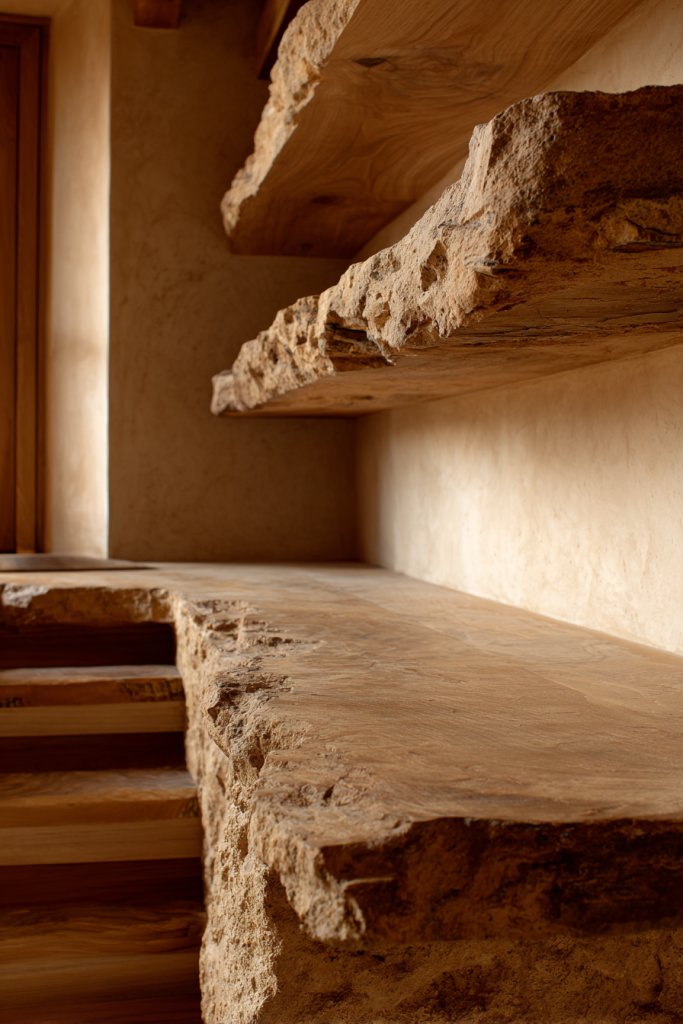
Overly polished, perfect edges can feel cold or artificial. Choosing shelving and countertops with simple, unfinished edges emphasizes natural forms and imperfections. It’s about celebrating organic beauty and craftsmanship in every detail. If you want a raw, authentic look, this is your go-to idea.
Picture floating wooden shelves with rough, chipped, or uneven edges that highlight the natural shape of the wood. Countertops with chipped or jagged edges have a tactile, rustic appeal that invites touch. These unrefined details contrast with smooth walls or sleek fixtures, creating a layered, organic aesthetic. The raw edges add visual interest and authenticity.
Use reclaimed or salvaged wood for shelves, embracing their imperfections. For countertops, opt for live-edge slabs or custom cuts that showcase natural contours. Keep finishes matte or lightly oiled to preserve the raw look. Seasonal accents like woven baskets or textured textiles can enhance the rustic charm.
Work with skilled carpenters or artisans to preserve the natural contours during cutting. Avoid excessive sanding or polishing—embrace the natural state. Seal surfaces minimally with natural oils or waxes that enhance grain without smoothing out edges. Mount shelves securely, ensuring stability despite irregular edges. Regularly inspect for splinters or damage and treat as needed.
Add handcrafted brackets or supports made from raw metals or wood. Incorporate decorative elements like carved motifs or natural stones. Use organic, textured textiles or baskets underneath for a layered look. Seasonal updates might include adding small sculptures or driftwood accents.
Unfinished edges celebrate the beauty of natural materials and craftsmanship, making your kitchen feel authentic and grounded. They age gracefully, developing character and patina over time. This approach encourages embracing imperfections and creating a truly organic space that feels alive and personal.
19. Eco-Friendly, Low-VOC Paint in Warm Neutrals

Standard paints often contain volatile organic compounds (VOCs) that can harm indoor air quality and the environment. Eco-friendly, low-VOC paints in warm neutral shades create a healthier, more sustainable space. They help reinforce the organic, natural vibe while keeping your home safe and fresh. If you’re eco-conscious, this choice is a no-brainer.
Imagine walls painted in soft taupe, warm beige, or clay tones—colors inspired by earth, sand, and stone. The matte finish absorbs light gently, creating a soothing backdrop. These hues complement natural wood, stone, and handcrafted accessories perfectly. The subtle warmth and texture foster a calm, inviting atmosphere.
Choose breathable, zero-VOC paints with natural mineral or clay bases for authenticity. Use different shades of neutrals for walls, trims, and ceilings to add depth. Seasonal or thematic accents can include textured wall treatments or natural fiber wall hangings. Keep the palette simple and cohesive to emphasize a grounded, organic feel.
Select brands dedicated to sustainability—many now offer beautiful, earthy tones. Prepare walls properly by cleaning and priming with eco-friendly solutions. Apply with brushes or rollers designed for low-VOC paints, and ensure good ventilation during application. Use natural fiber tapes and brushes to minimize chemical residues. Clean tools with water and gentle soaps, avoiding harsh chemicals.
Layer with textured wall finishes or paint effects for added depth. Use natural, untreated wood trims or baseboards to complement the walls. Combine with organic textiles and handcrafted decor for a fully earthy aesthetic. Seasonal updates might include adding subtle paint wash effects or accent colors inspired by nature.
Choosing eco-friendly, warm neutral paints aligns your home with sustainability and health. They create a serene backdrop that enhances natural materials and textures. Once you experience the clean air and beautiful hues, you’ll be motivated to keep your space eco-conscious and timeless. A healthier home starts with mindful choices.
20. Clay or Cement Sinks in Earthy Tones
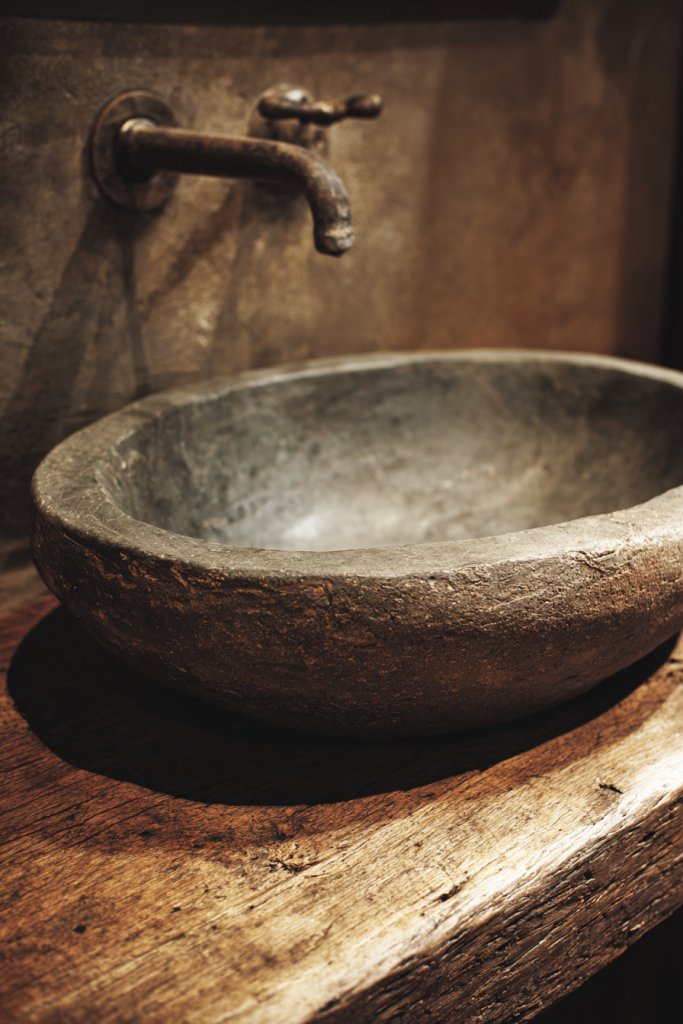
Overly shiny, synthetic sinks can clash with a natural, earthy kitchen. Clay or cement sinks in muted, earthy tones offer a rustic, tactile alternative. They add a sense of craftsmanship and grounding to your space. If you’re after a durable, statement feature, this idea is for you.
Visualize a matte, textured cement sink in warm taupe or clay red, with subtle imperfections that echo natural erosion. Its rough surface contrasts with sleek countertops or wooden accents, creating a layered, organic aesthetic. The earthy tones blend seamlessly with stone or reclaimed wood, emphasizing craftsmanship and durability. The tactile quality invites touch and adds visual weight.
Choose from hand-formed, custom-shaped sinks or prefabricated options with textured finishes. Pair with natural stones or wood for countertops to reinforce the earthy theme. Incorporate minimalist fixtures in matte black or aged bronze for cohesion. Seasonal accents like woven or linen accessories enhance the rustic feel.
Work with artisans or specialized manufacturers to create custom pieces. Ensure proper sealing and waterproofing to prevent damage. Use natural pigments or stains to achieve your desired tone—avoid glossy finishes. Regular cleaning with gentle, pH-neutral cleaners maintains the matte surface. Protect the surface from heavy impacts or abrasive cleaners.
Add carved or textured details, such as subtle patterns or motifs inspired by nature. Use handcrafted fixtures and rustic accessories to complement the sink. Incorporate natural textiles or baskets for organization nearby. Seasonal touches like mineral or clay pigments can refresh the look.
Clay and cement sinks connect your kitchen to earth’s raw beauty, emphasizing craftsmanship and durability. They age well and develop a unique patina that tells your story. Embracing these materials makes your space feel grounded, authentic, and stylish. Ready to make a bold, organic statement?
21. Organic Shape and Form in Kitchen Accessories
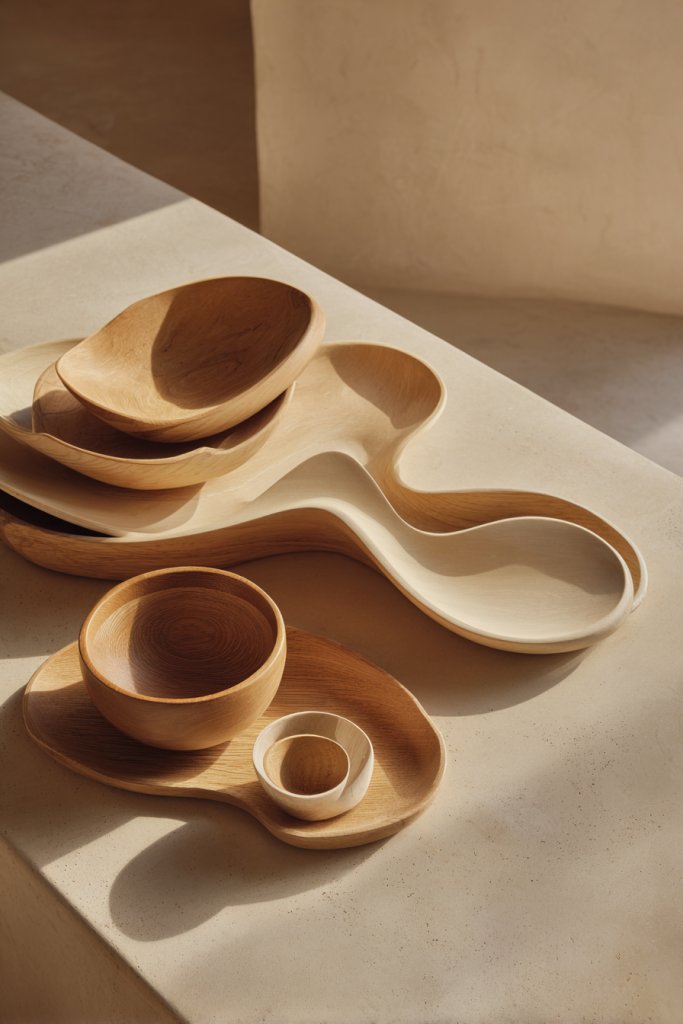
Standard kitchen accessories often feature rigid, geometric shapes that clash with organic decor. Choosing utensils, bowls, and trays in rounded, flowing forms adds harmony and softness. It’s about echoing nature’s curves and creating a visual flow that soothes the eye. If you crave a natural, unforced aesthetic, this idea is essential.
Imagine bowls with uneven, hand-formed rims and smooth, flowing contours in clay or wood. Utensil holders with gentle curves or trays with rounded edges evoke natural landforms or river flows. Their organic shapes contrast with and soften angular countertops or cabinets, creating a balanced, inviting environment. These accessories look like they grew out of nature itself.
Select items with rounded, asymmetrical, or flowing forms made from natural materials—clay, wood, or stone. Mix sizes and shapes to create visual interest. Incorporate sculptural or functional pieces—like rounded bowls or flowing trays—that serve practical purposes while acting as decor. Seasonal or thematic updates can involve adding textured or painted accents.
Work with artisans or craft your own in clay or wood, focusing on natural shapes and finishes. Use natural glazes or oils to enhance textures and protect surfaces. Display on open shelves or countertops, mixing with other organic materials. Regularly clean and inspect for chips or cracks, especially in handmade pieces. Incorporate storage solutions that mirror these shapes for a cohesive look.
Add engraved or painted details inspired by nature—leaf motifs, flowing lines, or wave patterns. Pair with textured textiles or woven baskets for a layered approach. Incorporate color accents inspired by earth tones—terracotta, moss green, or sandy hues. Seasonal updates might include adding small sculptural pieces or painted motifs.
Organic-shaped accessories connect your kitchen with nature’s flow and harmony. They create visual interest and cultivate a relaxed, natural atmosphere. Over time, they develop a patina that adds charm. Embrace natural forms and design a space that feels both calm and inspired.
22. Subtle Use of Natural Dyes in Kitchen Decor Accents
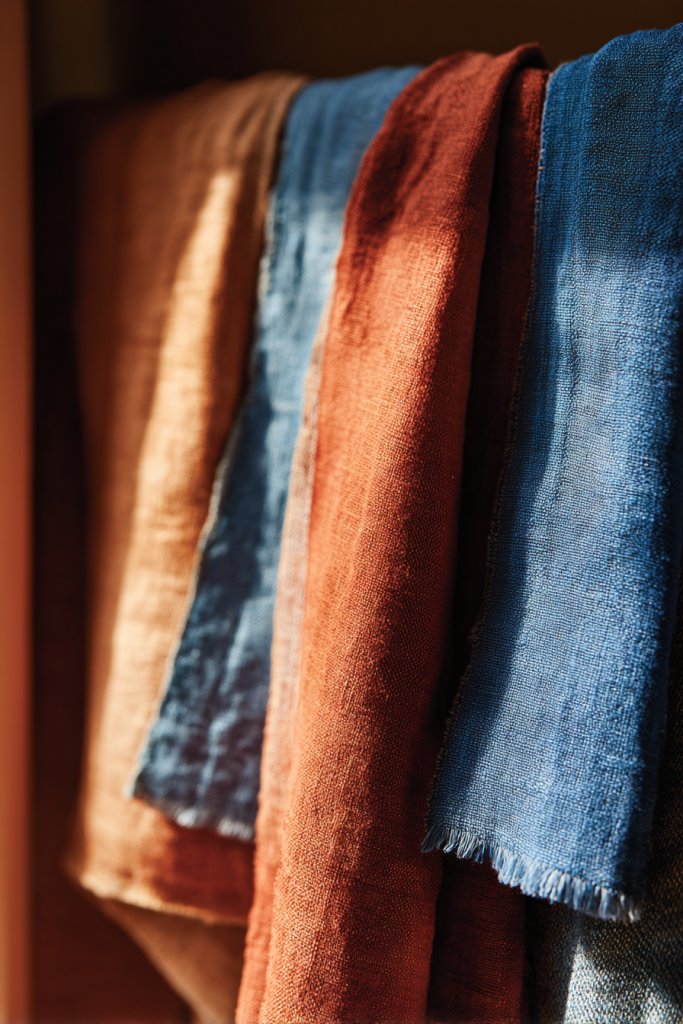
Bright synthetic dyes can feel out of place in a natural, earthy kitchen. Subtle use of plant-based dyes in textiles, ceramics, or artwork brings authenticity and gentle color. It’s about celebrating nature’s palette without overwhelming the senses. If you want a truly organic look, this idea is a subtle but impactful choice.
Imagine textiles or ceramics tinted with hues derived from indigo, turmeric, or madder root—muted, earthy shades that reflect the landscape. These accents, whether in napkins, placemats, or decorative ceramics, add depth and warmth. Their subtle coloration complements wood and stone, creating a harmonious, layered environment. The use of natural dyes showcases craftsmanship and environmental consciousness.
Choose textiles with natural dye-inspired hues—think warm ochre, deep greens, or soft browns. Incorporate small ceramics, bowls, or trays dyed with plant pigments for a cohesive look. Seasonal updates can involve swapping in new textiles or ceramics dyed with different botanicals. Keep the color palette understated to maintain the organic aesthetic.
Source from artisans or DIY using natural dyeing techniques—such as boiling plants or roots to extract pigments. Use eco-friendly, mordant-free methods to preserve the authenticity of dyes. Wash textiles gently and line dry to prevent fading. For ceramics, work with local potters or craft your own, ensuring the dyes are food-safe and non-toxic. Seal or glaze as needed for durability.
Personalize with embroidered or painted motifs inspired by nature—flowers, leaves, or abstract organic shapes. Pair with natural fiber textiles and handcrafted ceramics for a layered, earthy feel. Seasonal or thematic accents can include botanical prints or dyed linen table runners. These accents reflect your connection to nature and craftsmanship.
Using natural dyes in decor accents links your kitchen to the earth’s organic beauty. They age gracefully and develop a unique patina that adds character. These details celebrate sustainability and artistry, making your space truly unique. Embrace natural pigments and craft a warm, authentic environment.
Conclusion
From lush green accents to natural wood finishes and textured surfaces, these Earthy Kitchen Ideas provide a diverse array of ways to infuse warmth and authenticity into your space. Embrace these styles and let your creativity flourish—your dream organic kitchen is within reach. Start experimenting today and turn your kitchen into a peaceful retreat that celebrates the beauty of nature.
Leave a Reply